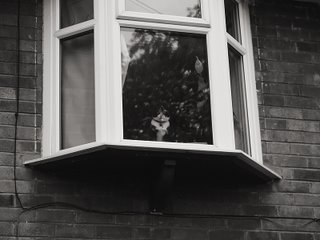Kitten at the Window
There is something tremulous, something slightly eerie about windows and the people who have a predeliction towards hovering round them all the time. I reckon it's something to do with Charlotte Bronte's Jane Eyre (1847) in which the eponymous heroine's irrepressibly passionate nature manifests, in childhood, in her fondness for bay windows, 'clear panes of glass, protecting but not separating me from the dreary November day'.
And why do windows inspire such strangeness? Because they are at once inside and outside, because they form the glassy boundaries between a reined-in, measured domesticity and boundless, stormy, unmediated forces of nature. A child of passion like Jane Eyre gravitates towards windows because they're not made for domestic life.
Bronte gives us a viewpoint from the insider: we read about Jane Eyre looking outwards. But, sometimes, in art and literature, we see such figures from the outside, and they still invoke a sense of uncertainty and unknowableness. This happens most famously in Hitchcock's Psycho (1960) in which the figure of a woman at a window signals to us that everything is not quite as it seems...

Fran, whose core identity turns on the central contradiction of being a once-feral kitten who now has owners, explores the fragile ambiguity of windows in this, the third of her series of self-portraits,'Kitten at the Window' (named, incidentally, after T.S.Eliot's similarly named poem). She's such a thoughtful bundle at times.

And why do windows inspire such strangeness? Because they are at once inside and outside, because they form the glassy boundaries between a reined-in, measured domesticity and boundless, stormy, unmediated forces of nature. A child of passion like Jane Eyre gravitates towards windows because they're not made for domestic life.
Bronte gives us a viewpoint from the insider: we read about Jane Eyre looking outwards. But, sometimes, in art and literature, we see such figures from the outside, and they still invoke a sense of uncertainty and unknowableness. This happens most famously in Hitchcock's Psycho (1960) in which the figure of a woman at a window signals to us that everything is not quite as it seems...

Fran, whose core identity turns on the central contradiction of being a once-feral kitten who now has owners, explores the fragile ambiguity of windows in this, the third of her series of self-portraits,'Kitten at the Window' (named, incidentally, after T.S.Eliot's similarly named poem). She's such a thoughtful bundle at times.


0 Comments:
Post a Comment
<< Home